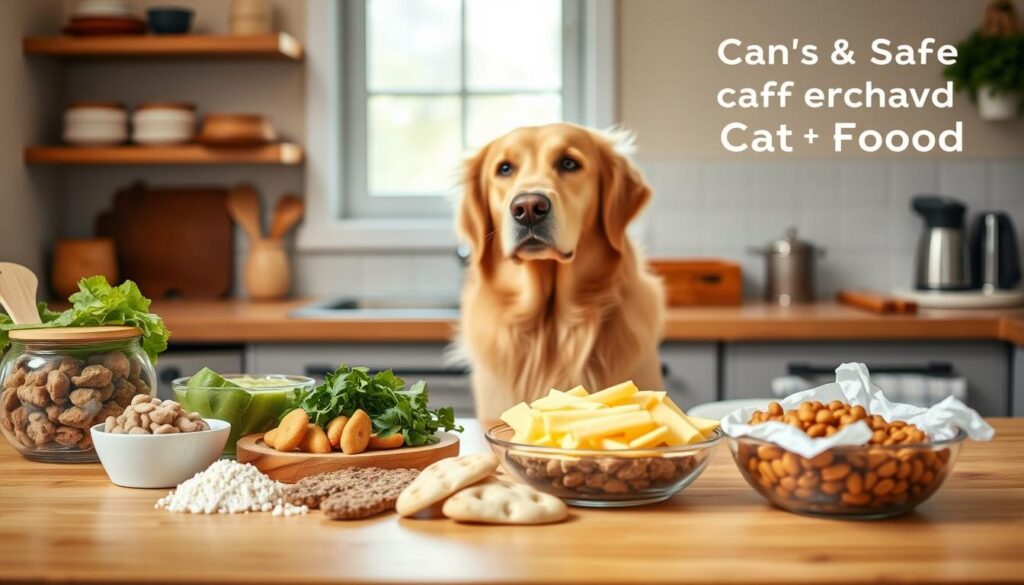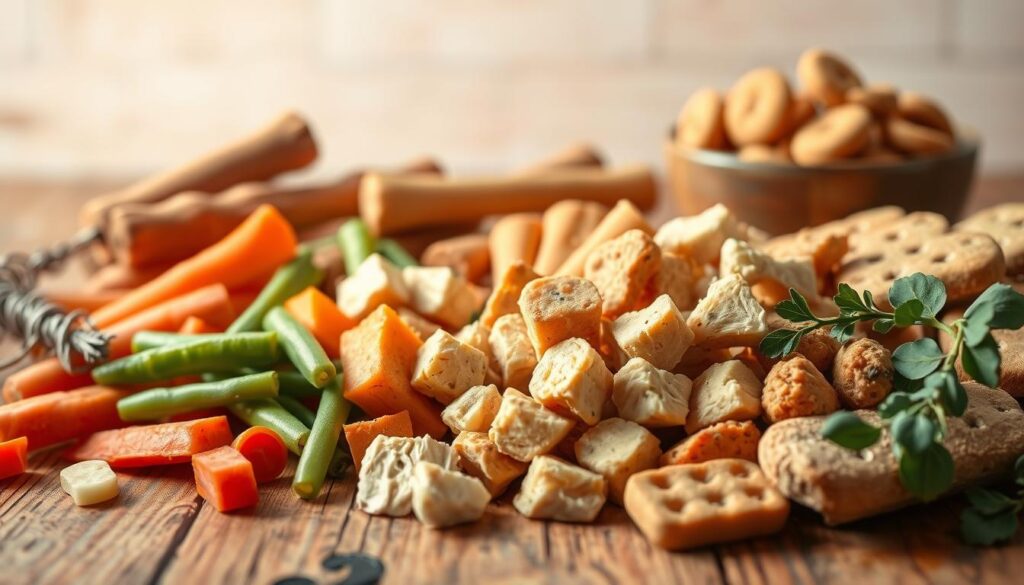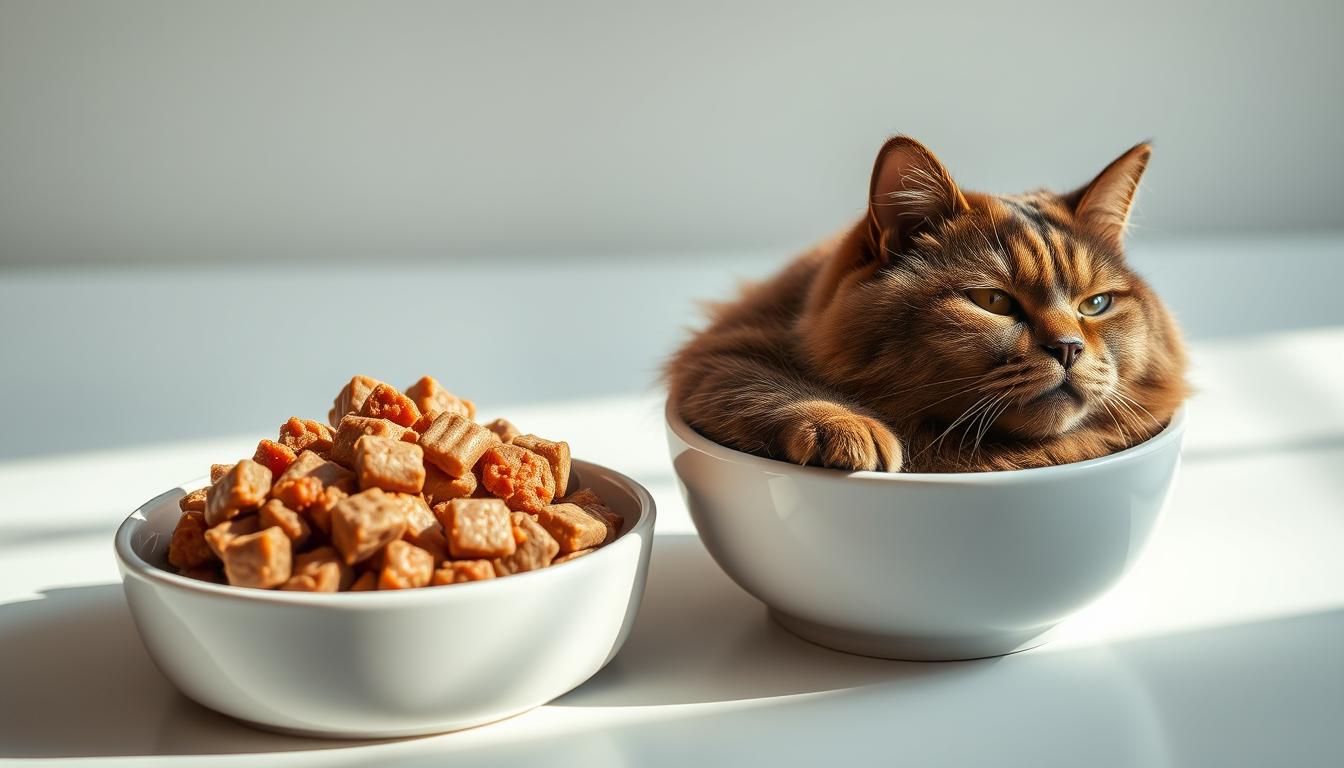can dogs eat cats food: If you’ve caught your dog sneaking a bite of your cat’s food, you’re not alone. Many pet owners wonder if dogs can eat cat food. While cat food isn’t harmful like chocolate or onions, it’s not good for dogs to eat it all the time. Experts say 90% of pet health problems come from bad diets.
Dogs need a mix of proteins, carbs, and fats because they eat both plants and animals. Cats, on the other hand, need more protein and a special amino acid called taurine because they are meat-eaters.
Keeping your pets safe means giving them the right food. The dog advisor says a little bit of cat food won’t hurt dogs. But eating it all the time can mess up their diet. This guide will tell you why cat food isn’t a good substitute for dogs. It will also talk about risks like getting too fat or having pancreatitis problems. Plus, it will give you tips on how to keep your pets safe.
Key Takeaways
- Cat food isn’t toxic to dogs but lacks essential dog-specific nutrients.
- 90% of pet health issues link to improper nutrition, highlighting the importance of species-appropriate diets.
- Cats require higher protein (30-50%) compared to dogs (18-25%), with unique amino acids like taurine.
- Regular cat food consumption may cause weight gain, digestive issues, or chronic health problems in dogs.
- Pet food safety requires understanding your dog’s life stage needs—puppies, adults, and seniors have distinct requirements.
The Common Scenario: When Your Dog Eats Cat Food
If your dog has ever eaten your cat’s food, you’re not alone. Dogs and cats diet needs are different. But cat food’s strong smell and taste can attract dogs. Experts say cat food has more protein and fats, which isn’t good for canine health.
“Given that it’s richer and full of tasty meat, you can’t really blame your dog for having their head turned by cat food.”
Why Dogs Are Attracted to Cat Food
- Cat food has more protein and fat than dog food.
- The smell and meat flavors are appealing to dogs.
- Cats’ food lacks fillers, making it taste stronger.
Immediate Concerns After Consumption
Mild reactions include:
- Stomach upset like vomiting or diarrhea
- Short-term stomach discomfort
These usually go away in a few hours. But if symptoms last or get worse, you need to act fast.
When to Contact Your Veterinarian
Seek help if your dog shows:
- Facial swelling or trouble breathing (possible allergic reaction)
- Continuous vomiting or feeling tired
- Signs of pain or discomfort
Ignoring serious symptoms can harm your dog’s canine health long-term. Quick action helps avoid risks.
Understanding the Nutritional Needs of Dogs vs. Cats
When it comes to pets nutrition, knowing the main differences between dogs and cats is crucial. Cats are strict carnivores, needing animal-based proteins to stay healthy. Dogs, being omnivores, can eat a broader range of foods. Here’s a look at their nutritional needs:
“Cats are obligate carnivores. This means they require meat in their diet and have a higher requirement for protein and fats, as well as other nutrients — including taurine.”
A feline diet comparison with dog food reveals big differences. Let’s dive into the details:
- Cats need 2–3x more protein than dogs to keep their muscles strong.
- Cats can’t make taurine and must get it from meat, unlike dogs.
- Dogs do well with moderate carbs (like grains) for energy, but cats can’t digest plant-based carbs well.
| Nutrient | Dogs | Cats |
|---|---|---|
| Protein % | 18-25% of diet | 22-30% of diet |
| Taurine | Not required | Critical for heart and eye health |
| Carbohydrates | Up to 50% tolerated | Non-essential, minimal tolerance |
| Water intake | Drink 1 cup water per 10 lbs body weight | Get hydration from wet food + water access |
Not understanding these differences can harm your pets’ health. Dogs eating cat food can gain weight from too much protein and fat. Cats on dog food might lack taurine and arachidonic acid. Always pick food made for their species to ensure they get the right nutrients.
The Fundamental Differences Between Dog and Cat Food
Knowing animal feeding guidelines starts with understanding the differences in dog and cat nutrition. Dogs and cats have unique needs that are reflected in their food. Here are the key differences:
Protein Content Comparison
Cat food has 30–40% protein because cats are obligate carnivores. Dog food has 18–25% protein. This difference is important because:
- Cats need taurine to prevent heart and eye problems, which is not in dog food
- Dogs can handle lower protein diets with plant-based ingredients
| Nutrient | Dog Food | Cat Food |
|---|---|---|
| Protein (%) | 18–25 | 30–40 |
| Fat (%) | 10–15 | 20–30 |
| Taurine | Not required | Mandatory |
Fat Levels and Types
Cat food has more animal-based fats, like arachidonic acid, which cats need but dogs don’t. Too much fat in cat food can cause problems in dogs, like pancreatitis.
Carbohydrate Differences
Dog foods have 30–50% carbs from grains and vegetables. Cats can’t digest these carbs well. So, carbs are not good for dogs unless the food is made for them.
Essential Vitamins and Minerals
Cat foods have extra vitamin A and niacin for their carnivore diet. Dog foods have more calcium and fiber for their omnivore diet. The main differences are:
- Cats need 3,332 IU vitamin A, while dogs need 5,000 IU
- Cat foods have arachidonic acid, which is not in dog food
“Dogs do well on balanced omnivore nutrition—never assume cat food is right for them,” says Laura Ward, a certified pet nutritionist.
To avoid feeding your dog the wrong food, follow these guidelines. Always check the labels to make sure the food meets your pet’s needs.
Can Dogs Eat Cats Food Occasionally? The Truth
While giving dogs cat food now and then might not hurt them right away, it depends on their health and eating habits. Vets say even a little cat food can upset a sensitive dog’s stomach. A study found that 90% of pet health problems come from bad diets, so making smart choices is key.
“Nutritional imbalances from cat food, though harmless once or twice, build up over time,” says Dr. Emily Carter, a canine nutritionist. “Regular feeding risks long-term health more than a single accident.”

- Breed predispositions: Miniature Schnauzers and Poodles face higher pancreatitis risks due to cat food’s high fat content.
- Health conditions: Dogs with kidney disease may suffer from excess protein in cat formulas.
- Age: Puppies and seniors have weaker metabolic systems to handle imbalances.
Cat food’s high protein and fat can cause weight gain or nutrient shortages over time. Some underweight dogs might get temporary benefits from cat food’s calories, but only with a vet’s watch. Always choose safe food for dogs made for their needs.
Stick to dog-specific diets unless your vet says otherwise. If your dog accidentally eats cat food, watch for vomiting or tiredness. For regular meals, pick brands like Royal Canin or Orijen that fit your dog’s breed and health.
Potential Health Risks of Feeding Cat Food to Dogs
Dogs might find cat food’s smell irresistible. But, eating it regularly can harm their canine health. Cat food has too much protein and fat for dogs, leading to digestive problems and long-term health issues. It’s important to know how these differences affect your dog’s health.
“90% of illnesses that cats and dogs suffer from can be traced back to inappropriate food.”—AVMA Nutrition Report
Digestive Issues and Upset Stomach
High-fat cat food can upset a dog’s stomach. Symptoms include:
- Vomiting or diarrhea
- Abdominal pain and bloating
- Loss of appetite or lethargy
Long-term Health Concerns
Feeding dogs cat food long-term can lead to health problems. Dogs don’t need the same nutrients as cats, which can cause:
- Kidney and liver strain from too much protein
- Pancreatitis in breeds like Miniature Schnauzers and Dachshunds
- Nutritional gaps in amino acids like arginine
Weight Gain and Obesity Risks
Cat food is high in calories, leading to quick weight gain. This can cause:
- Type 2 diabetes and joint problems
- Heart disease and a shorter lifespan
- Metabolic disorders from fatty acid imbalances
To protect canine health, avoid giving cat food as a regular diet. Talk to your vet about pet food safety. Choose dog-specific food that meets their nutritional needs.
Signs Your Dog Has Been Eating Too Much Cat Food
If you’ve ever wondered, can dogs eat cats food, it’s crucial to recognize the warning signs. Dogs eating cat food regularly can face health issues. Look for these red flags:
- Upset stomach: Vomiting, diarrhea, or loss of appetite within 24 hours.
- Weight gain: Sudden weight increase linked to cat food’s high fat content.
- Lethargy: Persistent low energy or reluctance to move.
- Coat changes: Dull fur or skin irritation from nutrient imbalances.
“Even small amounts of cat food can trigger digestive upset in sensitive dogs,” says Dr. Emily Carter, a veterinary nutritionist. “Monitor your dog closely if you notice recurring symptoms.”
Long-term effects may include pancreatitis from excess fat or vitamin deficiencies. If your dog shows what not to feed dogs symptoms like ongoing vomiting or refuses water, contact a vet immediately. Chronic exposure to cat food’s high protein can strain organs in senior dogs or those with preexisting conditions like kidney disease.
Prevention starts with awareness. Keep cat food out of reach and watch for behavioral changes like sneaking food. Early detection helps avoid costly vet bills and health complications. Always prioritize dog-specific nutrition to maintain their well-being.
How to Keep Your Dog Away From the Cat’s Food
Following proper animal feeding guidelines ensures both pets stay healthy while avoiding dietary conflicts. Dogs and cats have different diet needs. So, it’s important to protect your cat’s food. Here’s how to create a safe mealtime routine:
Physical Barriers and Feeding Stations
Start by using physical barriers to separate feeding zones. Elevate cat bowls using platforms like the Felines Only Cat Bowl. This blocks dogs while letting cats access their food. Automatic feeders like the SureFeed Microchip Pet Feeder open only for your cat via ID tags.
For tight spaces, Door Buddy latches can secure rooms where cats eat. These solutions align with animal feeding guidelines to prevent dietary mix-ups.
Timing Meals Strategically
- Feed pets in separate rooms during scheduled times.
- Supervise meals to ensure dogs don’t linger near cat food areas.
- Use the 15-30 minute cat meal window to your advantage—remove cat food promptly after your cat finishes.
Training Techniques for Multi-Pet Households
Teach your dog the “leave it” command during meal prep. Mental stimulation toys like puzzle feeders reduce food-seeking behavior. Consistent training can cut food theft by 40%, easing competition.
Always reward good behavior to reinforce positive habits.
Safe Alternatives for Treating Your Dog
When your dog wants a treat, choose safe food for dogs that meets their needs. Stay away from cat food and look into these alternatives:

- Protein-rich options: Plain cooked chicken, turkey, or beef. These give protein without the fat in cat food.
- Vegetables: Carrots, green beans, or steamed pumpkin for fiber and vitamins.
- Fruits: Blueberries, apples (seed-free), or bananas in small amounts. Avoid grapes/raisins, as they are toxic.
- Commercial treats: Choose brands like Wellness or Orijen, recommended by pet food safety experts at Dog Food Advisor.
For a change, try eggs (fully cooked) or unsalted peanut butter. Treats should not make up more than 10% of your dog’s diet. Dogs like Miniature Schnauzers or those prone to pancreatitis should avoid high-fat foods. Look for treats with real meat as the first ingredient and avoid artificial additives.
“Choose ingredients you know to ensure safe food for dogs,” advises Dog Food Advisor’s nutrition guide.
Switch up treats to keep things interesting. For dogs with sensitive stomachs, try plain chicken and rice. Always talk to your vet before adding new foods, especially for diabetic dogs or those with allergies. Keeping an eye on pet food safety ensures your dog stays happy and healthy while meeting their dietary needs.
Special Considerations for Puppies and Senior Dogs
Puppies and senior dogs need special diets because of their life stages. Their pets nutrition needs are different from adult dogs. This makes cat food a bad choice for them. Here’s what you need to know.
Age-Specific Nutritional Requirements
- Puppies need 3–4 meals a day with the right mix of protein, fats, and minerals for growth. Cat food’s high phosphorus and calories can harm their bones.
- Senior dogs (7+ years) do better with fewer calories and ingredients that help their joints, like glucosamine. Cat food’s high protein can hurt their aging kidneys.
- AAFCO guidelines say age-specific formulas are key. Never use cat food, which lacks these important blends.
Health Vulnerabilities by Age
- Puppies’ still-growing digestive systems might get upset by cat food’s rich ingredients, leading to diarrhea or vomiting.
- Seniors with kidney disease face more risks from cat food’s protein. Obesity (56% in U.S. dogs) gets worse with calorie-rich diets.
- Joint health in seniors and immune development in puppies depend on the right dog food, not cat food.
Keeping canine health in check means no shortcuts. Always talk to a vet before changing diets, especially for puppies and seniors. Choose age-specific formulas to prevent long-term harm.
Myths About Dogs and Cat Food Debunked
Can dogs eat cats food? Many pet owners believe myths that overlook critical nutritional differences. Let’s address common misconceptions to protect your dog’s health.
- Myth: Dogs enjoy cat food, so it must be good for them.
Reality: Preference ≠ nutrition. Feline diet comparison reveals cat food lacks nutrients dogs need, like fiber and specific vitamins. - Myth: Cat food is better because it’s more expensive.
Reality: Cost reflects feline-specific needs. Dogs require tailored diets for optimal health. - Myth: Mixing cat and dog food creates a balanced diet.
Reality: Combining foods risks imbalances. Dogs need consistent, species-appropriate nutrition. - Myth: Occasional cat food feeding is harmless.
Reality: Even small amounts can disrupt digestion. Regular exposure increases long-term risks like obesity or organ strain. - Myth: Some dog breeds tolerate cat food better.
Reality: All dogs share the same risks. No breed is exempt from nutrient mismatches.
Understanding the feline diet comparison shows why dogs thrive on their own formulas. Always consult your vet before changing your dog’s diet. Prioritize science over myths to keep your pet healthy.
Conclusion: Finding the Right Balance in Your Multi-Pet Household
Keeping a dogs and cats diet right is key for their health. Cat food has too much protein and fat for dogs, leading to obesity and kidney problems. Feeding them separately helps both pets stay healthy.
Choosing the right food for dogs is important. It should not be the high-calorie cat food. With over 94 million cats and 89 million dogs in the U.S., owners play a big role in their diet. Using feeding stations and training can stop pets from eating each other’s food.
Even though 70% of pet owners like dry food, it’s crucial to match their diet to their species. The International Canine Federation says 147 million dogs worldwide need balanced diets. Following these rules helps keep your home peaceful. Experts say, “Your cat and dog deserve separate food bowls to stay healthy and happy long-term.”
FAQ
Can dogs eat cat food without immediate harm?
Why do dogs like cat food so much?
What should I watch for after my dog eats cat food?
When should I contact my veterinarian?
What are the basic nutritional differences between dogs and cats?
How do protein and fat levels differ between dog and cat food?
Are there health risks for dogs that regularly eat cat food?
How can I tell if my dog has been eating cat food excessively?
What are some practical ways to keep my dog away from cat food?
What are safe alternatives to cat food for treating my dog?
Why is cat food particularly unsuitable for puppies and senior dogs?
What common myths exist about dogs eating cat food?
Source Links
- Can I give cat food to my dog? | zooplus Magazine – https://www.zooplus.co.uk/magazine/dog/dog-nutrition/can-i-give-cat-food-to-my-dog
- Dog vs. Cat Nutrition: Essential Dietary Differences – https://purrfectgrooming.pet/blog/b/dietary-differences-understanding-the-nutritional-needs-of-dogs-and-cats/
- Can Dogs Eat Cat Food? | Dog Food Advisor – https://www.dogfoodadvisor.com/canine-nutrition/can-dogs-eat-cat-food/
- What Can Dogs Not Eat | Discover Toxic Foods & Foods that are Bad for Dogs – https://www.embracepetinsurance.com/waterbowl/article/what-can-dogs-not-eat-toxic-foods-for-dogs-list
- Is Homemade Dog Food & Cat Food Better? [Ask a Vet] – https://www.splootvets.com/post/is-homemade-dog-food-cat-food-better
- Feeding Fido and Fluffy: Understanding the Nutritional Needs of Dogs a – https://pawnaturals.com/blogs/default-blog/feeding-fido-and-fluffy-understanding-the-nutritional-needs-of-dogs-and-cats?srsltid=AfmBOooqOQ9uA51zIaUBcUZp_oZ8WhinESP5sFQMOJgopvyqtguRX6wT
- No title found – https://www.akc.org/expert-advice/nutrition/can-dogs-eat-cat-food/
- Can Dogs Eat Cat Food? – https://www.petmd.com/dog/nutrition/can-dogs-eat-cat-food
- Can Dogs Eat Cat Food? Vet-Verified Info & Safety Tips – Dogster – https://www.dogster.com/dog-nutrition/can-dogs-eat-cat-food
- Can My Dog Eat Cat Food? – https://www.tasteofthewildpetfood.com/health/nutrition/can-my-dog-eat-cat-food/
- Can Dogs Eat Cat Food? Should They? – https://www.kinship.com/dog-nutrition/can-dogs-eat-cat-food
- 6 Ways to Make a Dog Proof Cat Feeder – https://www.thedoorbuddy.com/blogs/door-buddy/6-ways-to-make-a-dog-proof-cat-feeder?srsltid=AfmBOopFAn-lSU6aBy1X_Z5ppXIuTFYFkjpqy96omx004kwK4WlSkhnS
- 9 Ways to Keep Your Dog Out of Your Cat’s Food – Dogster – https://www.dogster.com/dog-nutrition/how-to-keep-your-dog-out-of-your-cats-food
- My Dog Ate Cat Food – Now What? – https://www.veterinaryemergencygroup.com/post/my-dog-ate-cat-food-now-what
- 19 Healthy and Safe Foods You Can Feed Your Dog – https://www.carecredit.com/well-u/pet-care/healthy-food-for-dogs/
- A Guide to Feeding at Every Life Stage – Victory Animal Hospital Hong Kong – https://victoryanimalhospital.com/tailored-nutrition-for-your-pet-a-guide-to-feeding-at-every-life-stage/
- Understanding Your Dog’s Nutritional Needs for Different Life Stages – https://www.hudsonanimalhospitalnyc.com/services/dogs/blog/understanding-your-dogs-nutritional-needs-different-life-stages/
- Food Fallacies: Debunking Common Pet Nutrition Myths – Palisades Veterinary Hospital – https://palisadesvet.com/food-fallacies-debunking-common-pet-nutrition-myths/
- Is Milk Good for Cats? Debunking Popular Cat Food Myths – https://cats-magazine.com/education/is-milk-good-for-cats-and-other-myths-you-shouldnt-believe/
- Is Cat Food Bad for Dogs? What’s Safe for Dogs to Eat? – https://michu.com.au/blogs/news/dog-can-eat-cat-food?srsltid=AfmBOorEFI6DCN7BzaK5ok4L4RVdZP6SBR-4GY8j7WuiMZQ_3nh7hXw-
- Raw Food Diet for Pets: Benefits and Risks Explained – https://www.zumalka.com/blogs/blog-pet-health/raw-food-diet-benefits-and-risks-for-pets?srsltid=AfmBOorUr2bsFHVUSAwE5vFwftQ2s7D0F72DhCE_eVp6Akx3tX-Ey9D9
- Frontiers | The science of snacks: a review of dog treats – https://www.frontiersin.org/journals/animal-science/articles/10.3389/fanim.2024.1440644/full
